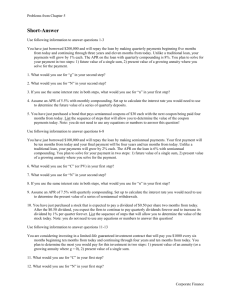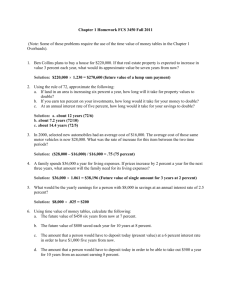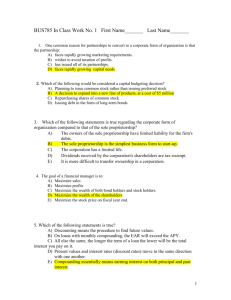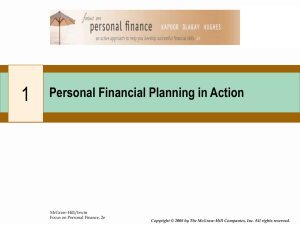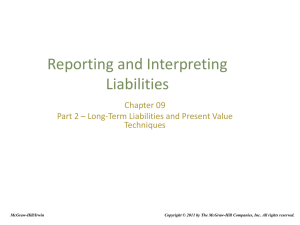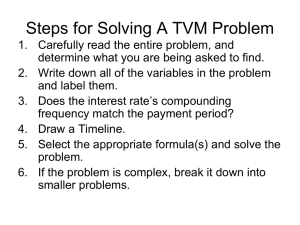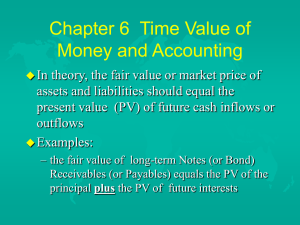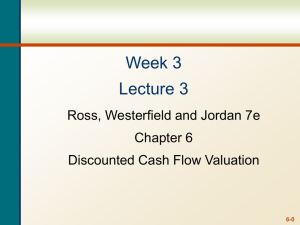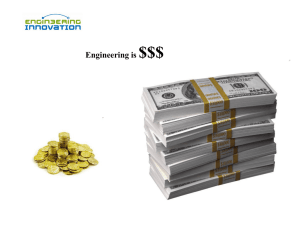Note: For any question with numbers, all of the points are earned by
advertisement
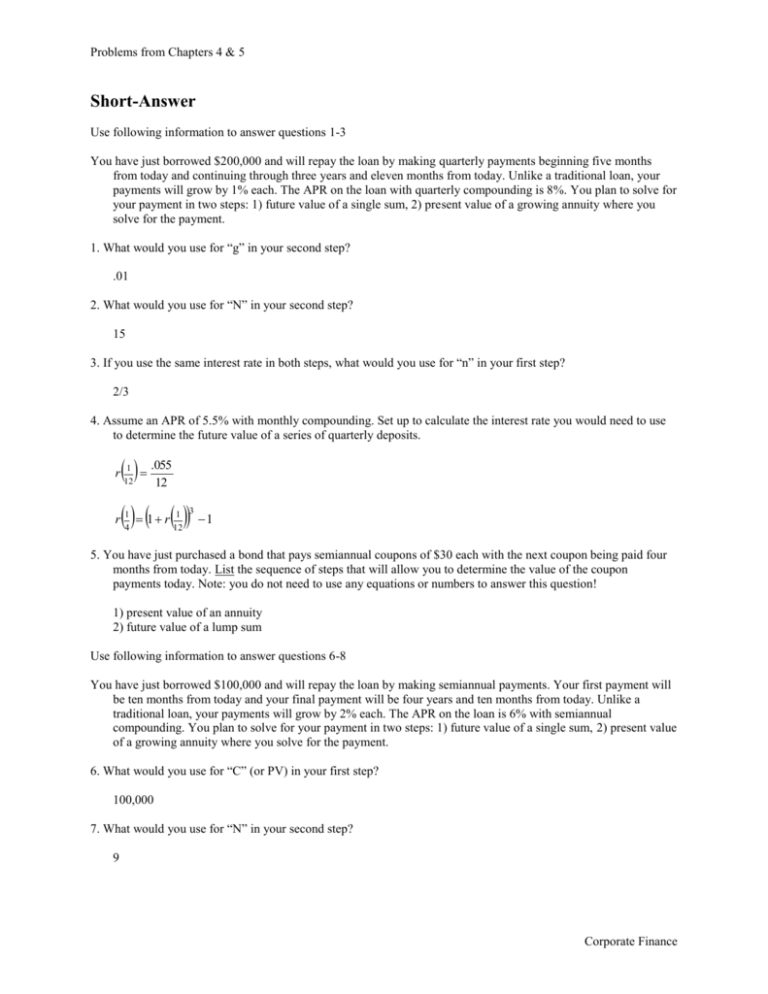
Problems from Chapters 4 & 5 Short-Answer Use following information to answer questions 1-3 You have just borrowed $200,000 and will repay the loan by making quarterly payments beginning five months from today and continuing through three years and eleven months from today. Unlike a traditional loan, your payments will grow by 1% each. The APR on the loan with quarterly compounding is 8%. You plan to solve for your payment in two steps: 1) future value of a single sum, 2) present value of a growing annuity where you solve for the payment. 1. What would you use for “g” in your second step? .01 2. What would you use for “N” in your second step? 15 3. If you use the same interest rate in both steps, what would you use for “n” in your first step? 2/3 4. Assume an APR of 5.5% with monthly compounding. Set up to calculate the interest rate you would need to use to determine the future value of a series of quarterly deposits. r r .055 12 1 12 1 r 1 1 4 1 3 12 5. You have just purchased a bond that pays semiannual coupons of $30 each with the next coupon being paid four months from today. List the sequence of steps that will allow you to determine the value of the coupon payments today. Note: you do not need to use any equations or numbers to answer this question! 1) present value of an annuity 2) future value of a lump sum Use following information to answer questions 6-8 You have just borrowed $100,000 and will repay the loan by making semiannual payments. Your first payment will be ten months from today and your final payment will be four years and ten months from today. Unlike a traditional loan, your payments will grow by 2% each. The APR on the loan is 6% with semiannual compounding. You plan to solve for your payment in two steps: 1) future value of a single sum, 2) present value of a growing annuity where you solve for the payment. 6. What would you use for “C” (or PV) in your first step? 100,000 7. What would you use for “N” in your second step? 9 Corporate Finance Problems from Chapters 4 & 5 8. If you use the same interest rate in both steps, what would you use for “n” in your first step? 4/6 9. Assume an APR of 7.5% with quarterly compounding. Set up to calculate the interest rate you would need to use to determine the present value of a series of semiannual withdrawals. r r .075 4 1 4 1 r 1 2 1 2 4 1 10. You have just purchased a stock that is expected to pay a dividend of $0.50 per share two months from today. After the $0.50 dividend, you expect the firm to continue to pay quarterly dividends forever and to increase its dividend by 1% per quarter forever. List the sequence of steps that will allow you to determine the value of the stock today. Note: you do not need to use any equations or numbers to answer this question! 1) present value of a growing perpetuity 2) future value of a lump sum Use following information to answer questions 11-13 You are considering investing in a limited-life guaranteed investment contract that will pay you $1000 every six months beginning ten months from today and continuing through four years and ten months from today. You plan to determine the most you would pay for this investment in two steps: 1) present value of an annuity (or a growing annuity where g = 0), 2) present value of a single sum. 11. What would you use for “C” in your first step? 1000 12. What would you use for “N” in your first step? 9 13. If you use the same interest rate in step 2) that you did in step 1, what would you use for “n” in your second step? 4/6 14. Assume an APR of 8% with quarterly compounding. Set up to calculate the equivalent interest rate you would need to use to determine the present value of a series of monthly deposits. r r .084 1 4 1 r 1 12 1 13 4 1 Corporate Finance Problems from Chapters 4 & 5 15. You have just invested $1000 in a security that will make quarterly payments to you. The first payment will occur nine months from today, the last payment will occur five years from today, and each subsequent payment will grow by 1% each. List the sequence of steps you that would allow you to determine the size of the first and fourth payments you can expect to receive. If you are not solving for the “name” of the step (such as the present value of a single sum), state what you are solving for (such as payment or interest rate or number of payments). Assume you have an interest rate that you can use to calculate present or future values. Note: you do not need to use any equations or numbers to answer this question! Future value of a single cash flow Present value of a growing annuity, solve for payment Future value of a single cash flow Note: future value of a growing annuity will also work Use following information to answer questions 16 – 18 You are considering investing enough in an amortized CD at your bank that the CD will pay you $100 every six months beginning seven months from today and continuing through four years and one month from today. You plan to determine how much you will need to invest in two steps: 1) present value of an annuity (or a growing annuity where g = 0), 2) present value of a single sum. 16. What would you use for “C” in your first step? 100 17. What would you use for “N” in your first step? 8 18. If you use the same interest rate in step 2) that you did in step 1, what would you use for “n” in your second step? 1/6 19. Assume an APR of 6% with monthly compounding. Set up to calculate the equivalent interest rate you would need to use to determine the present value of a series of semiannual deposits. r r .1206 1 12 1 r 1 2 1 6 12 1 20. You have just invested $5000 in a security that will make semiannual payments to you. The first payment will occur one year from today, the last payment will occur five years from today, and each subsequent payment will grow by 2% each. List the sequence of steps you that would allow you to determine the size of the first and third payment you can expect to receive. If you are not solving for the “name” of the step (such as the present value of a single sum), state what you are solving for (such as payment or interest rate or number of payments). Assume you have an interest rate that you can use to calculate present or future values. Note: you do not need to use any equations or numbers to answer this question! Future value of a single cash flow Present value of a growing annuity, solve for payment Future value of a single cash flow Note: future value of a growing annuity will also work Corporate Finance Problems from Chapters 4 & 5 Use following information to answer questions 21-23 You are considering investing with a friend who is starting a small business. He has promised to make quarterly payments that increase by 1% each. Your first payment would be $100 and would occur seven months from today and your final payment would occur two years and ten months from today. You plan to determine the most you would invest in the business in two steps: 1) present value of a growing annuity, and 2) present value of a lump sum. 21. What would you use for “C” in your first step? 100 22. What would you use for “N” in your first step? 10 23. If you use the same interest rate in step 2) that you did in step 1, what would you use for “n” in your second step? 4/3 24. Assume an APR of 9% with semiannual compounding. Set up to calculate the equivalent interest rate you would need to use to determine the present value of a series of monthly deposits. r r .092 1 2 1 r 1 12 1 16 2 1 25. Your goal is to have $100,000 saved by three years from today. As a result, you have just made the first of a series of monthly deposits into a savings account. You plan for each deposit to grow by 1% each but will make your final deposit two years from today (you will continue to earn interest on the account until you withdraw the money three years from today). List the sequence of steps you that would allow you to determine how large your first and third deposits will need to be. If you are not solving for the “name” of the step (such as the present value of a single sum), state what you are solving for (such as payment or interest rate or number of payments). Assume you have an interest rate that you can use to calculate present or future values. Note: you do not need to use any equations or numbers to answer this question! Present value of a single cash flow Future value of a growing annuity, solve for payment Future value of a single cash flow Note: present value of a growing annuity will also work 26. Assume you invest in a 1-year Treasury offering a return of 0.4%. If inflation ends up being 18% over the next year, calculate the real return on your investment. . 004 − .18 1.18 27. Your firm is considering investing $500,000 in a project that will generate annual cash flows that will begin four months from today and which will continue forever. After an initial cash inflow of $25,000, the net inflows will shrink each year. List the sequence of steps that would allow you to solve for a cost of capital that would make the net present value of the project equal to zero. For each step, list the variable you are solving for. 1) PV of single sum (PV), 2) PV of perpetuity Corporate Finance Problems from Chapters 4 & 5 28. How does an APR differ from an effective interest rate? An APR ignores the impact of compounding 29. You have just deposited $350,000 into a savings account and plan to make your first annual withdrawal seven months from today and your final annual withdrawal 11 years and 7 months from today. Your first withdrawal will equal $90,000. List the steps and the order in which you would solve them to determine the rate at which your annual withdrawals can grow. For each step, list the variable you are solving for. 1) PVLS(PV); 2) PVGA(g) Use the following information to answer questions 30 and 31. You have a savings account into which your parents made monthly deposits since you were born. Their last deposit was six months ago and the current balance in your account is $4000. The interest rate on the account is 0.1% per month. 30. What sequence of steps would allow you to solve for the size of your parents’ deposits? Note: for each step, list what type of time value of money calculation you are doing and what variable you are solving for. Example: 1) future value of a single cash flow (solve for future value); 2) present value of a perpetuity (solve for the interest rate). PV of single cash flow (solve for PV); FV of annuity (solve for payments). 31. What would you use for N or n in your first step? Note that the “first step” is the one you would calculate first if you were actually solving for the size of the deposits. 6 32. The nominal return on a savings account was 5% over the past year. What information would you need and how would you use this information to estimate the real return on this account over the past year? inflation rate; rreal .05 i 1 i Corporate Finance Problems from Chapters 4 & 5 Problems 1. You have just started a business that will provide a net cash flow of $10,000 one year and two months from today. After this initial cash flow the business will generate quarterly cash flows that shrink by 1% per quarter. The final cash flow will occur three years and eight months from today. What is the value of these cash flows today if you need to earn the equivalent of your savings account which has an APR of 7.5% with semiannual compounding? 11 1 .01 10 ,000 PV11mo 1 1 r .01 1 r 1 4 4 .075 2 r 1 r r 1 2 1 12 2 1 4 PV0 1 PV11mo 1 r 1 11 3 4 2. Two months from today, you plan to make the first of a series of semiannual deposits into an account that has an APR of 5% per year with monthly compounding. You plan for each deposit to be 1.5% larger than the previous one and plan to make your final deposit three years and eight months from today. After your final deposit, you will let your account sit until four years from today when you plan to withdraw $100,000. How large will be your final semiannual deposit? r r .1205 1 12 1 r 1 1 2 1 6 12 PV3 yrs,8mo 100 ,000 1 r 1 4 12 C FV3 yrs,8mo 1 2mo 1 r r .015 2 1.015 1 8 2 8 C3 yrs,8mo C2mo 1.0157 Corporate Finance Problems from Chapters 4 & 5 3. You have just deposited $100,000 into an account that earns an APR of 9% with compounded monthly compounding. You will make the first quarterly withdrawal from this account two months from today and your last quarterly withdrawal from this account five years and eleven months from today. If you plan to decrease each withdrawal by 2%, what is the size of your final withdrawal? r r .1209 1 12 1 r 1 1 3 12 1 4 PV1mo PV 1mo 100 ,000 1 r 1 1 12 C 1 .02 2 mo 1 1 r .02 1 r 1 4 4 24 C5 yr ,11mo C 2mo 1 .0223 4. You have just made the first of a series of equal monthly deposits into a savings account that pays an APR of 3% per year with monthly compounding and you plan to make your final deposit one year and two months from today. Two years from today, you plan to make the first of a series of semiannual withdrawals from the account. You plan for your first withdrawal from the account to equal $5000 and you would like each subsequent withdrawal to be 1% larger than the previous one. You plan to continue making these semiannual withdrawals through five years from today. Calculate how large each of your deposits must be to achieve your goal. 1 .03 12 12 𝑟( ) = 1 1 6 𝑟 ( ) = (1 + 𝑟 ( )) − 1 2 12 7 5000 𝑃𝑉1𝑦𝑟,6𝑚𝑜 = ( 1 2 1.01 ) (1 − ( 𝑟( )−.01 1 2 ) ) 1+𝑟( ) 4 𝑃𝑉1𝑦𝑟,2𝑚𝑜 = 𝑃𝑉1𝑦𝑟,6𝑚𝑜 ( 1 ) 1 1+𝑟( ) 12 𝐹𝑉1𝑦𝑟,2𝑚𝑜 = 𝐶 1 𝑟( ) 12 1 15 ((1 + 𝑟 ( )) 12 − 1) = 𝑃𝑉1𝑦𝑟,2𝑚𝑜 => solve for C Corporate Finance Problems from Chapters 4 & 5 5. Two months from today, you are planning to make the first of a series of monthly deposits of $100 each into a savings account that pays an APR of 4% per year with monthly compounding. You will make the final deposit one year from today. Your first quarterly withdrawal from the account will be one year and eight months from today and your final withdrawal will be three years and eleven months from today. Calculate how large your first withdrawal can be if you plan for each withdrawal to be 0.5% larger than the previous one. 1 .04 12 12 𝑟( ) = 3 1 1 4 12 𝑟 ( ) = (1 + 𝑟 ( )) − 1 𝐹𝑉1𝑦𝑟 = 100 1 1 𝑟( ) 12 11 ((1 + 𝑟 ( )) − 1) 12 5 1 𝐹𝑉1𝑦𝑟,5𝑚𝑜 = 𝐹𝑉1𝑦𝑟 (1 + 𝑟 ( )) 12 10 𝐶 𝑃𝑉1𝑦𝑟,5𝑚𝑜 = ( 1 𝑟( )−.005 4 ) (1 − ( 1.005 1 1+𝑟( ) 4 ) ) => solve for C 6. Your firm has an opportunity to build a new facility for $100,000 today. The facility will produce its first net quarterly cash flow of $5000 seven months from today. After this initial cash flow, quarterly cash flows will increase by 1% per quarter through the final cash flow three years and ten months from today. If the project’s cost of capital equals 8% (an APR with monthly compounding), calculate the net present value of the project? .1208 r 1 r 1 r 1 12 1 3 12 1 4 Inflows: 1.01 1 .01 1 r 1 4 5000 PV4mo r PV0 PV4 mo 1 4 14 1 r 1 4 12 NPV = PV0 – 100,000 7. Galaxy Enterprises is considering whether or not to build a new factory which will require an investment of $500,000 today and $600,000 three months from today. The factory will produce its first annual cash flow of $100,000 five months from today. These annual cash flows will grow by 1.5% per year through 17 years and five months from today. Assuming the cost of capital for the project is 12% per year (effective annual rate), calculate the net present value of the factory. NPV 500 ,000 600 ,000 1.12 3 12 18 100 ,000 1.015 7 12 1 1.12 .12 .015 1.12 Corporate Finance Problems from Chapters 4 & 5 8. You are considering buying a bond that matures 15 years from today for $1000 and pays a coupon of $40 every six months until it matures. What cash flows would you pay and receive from your investment if the return on the bond is 6% now and 7% when you sell it 2 years from today (just after a coupon is paid)? Note: be sure to indicate when cash flows occur starting with today and to use a “+” for inflows and a “-“ for outflows. Note also that returns on bonds with semiannual coupons are given as APRs with semiannual compounding. PV 0 40 1 1 .03 1.03 PV 2 40 .035 30 30 1000 1 1.03 26 1 26 1 1 1000 1.035 1.035 Cash flow: 0 = -PV0; ½ = +40; 1 = +40; 1½ = +40; 2 = +40 + PV2 9. You have just deposited $50,000 into a savings account that pays an APR of 7.5% with monthly compounding. You plan to use the account to make semiannual withdrawals with your 1 st withdrawal coming 4 months from today and your final withdrawal coming 4 years and 4 months from today. How large can you make your first withdrawal if you plan for your semiannual withdrawals that grow by 1.5% each after the first withdrawal? .075 12 r 1 r r 1 12 1 6 12 1 2 50 ,000 1 r 1 2 12 r 1 1 2 1.015 1 .015 1 r 1 2 C 9 => solve for C 10. A risk-free security that pays $100 per year for 7 years beginning one year from today currently sells for $550. Assume that you can borrow or lend at the risk-free interest rate of 4.5% per year. a. What set of transactions would allow you to earn an arbitrage profit? b. Calculate your arbitrage profit. PV = 100 1 1 .045 1.045 7 589 .27 a. Buy security; borrow PV of $100 due at end of each of the next 7 years (or short-sell risk-free bonds that pay off $100 at end of each of the next 7 years). b. 589.27 – 550 = +39.27 Corporate Finance Problems from Chapters 4 & 5 Multiple-Choice Use the following information to answer questions 1 and 2: You have just made a deposit of $500 into a savings account that will allow you to make semiannual withdrawals that continue forever and that will increase by 1% each beginning four months from today. 1. What sequence of calculations will allow you to solve for your first withdrawal? A. present value of single sum (solve for present value) then present value of a perpetuity b. future value of an annuity (solve for future value) then present value of a single cash flow c. future value of a single sum (solve for future value) then present value of a perpetuity d. present value of an annuity(solve for present value) then present value of a perpetuity e. none of the above will work 2. What variable will you solve for in your last step in the previous question? a. PV B. C or PMT c. N or n d. r (or I) e. FV 3. Two months from today, you are planning to make the first of a series of equal monthly deposits into a savings account that pays an APR of 6% per year with monthly compounding. You will make the final deposit one year from today. Your first quarterly withdrawal of $1000 will be one year and eight months from today and your final quarterly withdrawal will be three years and eleven months from today. Assume you want to calculate how large your deposits must be if you plan for each withdrawal to be 0.5% smaller than the previous one. If you start with the withdrawals, what sequence of steps will allow you to solve for your deposits? a. future value of an annuity (solve for future value), future value of a single cash flow b. present value of an annuity (solve for present value), future value of an annuity c. present value of an annuity (solve for present value), present value of a single cash flow D. present value of an annuity (solve for present value), present value of a single cash flow, future value of an annuity e. two of the above will work Use the following information to answer questions 4 through 7: Your firm has an opportunity to build a new factory today for $1,000,000. Eight months from today, the factory will generate a net cash flow of $112,500. After this initial cash flow, the factory will generate semiannual cash flows through five years and two months from today. The cost of capital for the project is 7.5% per year. In order to calculate the rate at which the cash flows must grow for the net present value of the factory to equal zero, you plan to calculate the future value of a single cash flow and then the present value of an annuity. Assume that you use the same interest rate in both equations. 4. When calculating the future value of a single cash flow, what would you use for n (or N)? a. 2.333333 B. 0.333333 c. 8 d. 1.166667 e. 7 5. When calculating the present value of an annuity, what would you use for C (or PMT)? a. 250,000 b. 125,000 c. 225,000 D. 112,500 e. 1,000,000 Corporate Finance Problems from Chapters 4 & 5 6. When calculating the present value of an annuity, what would you use for N? a. 9 b. 8 c. 19 d. 11 E. none of the above 7. What would you use for r (or I)? A. .03682 b. .0375 c. .03785 d. .075 e. .07714 Use the following information to answer questions 8 through 11: You have just purchased a car and have arranged financing through the dealer where your first monthly payment of $500 each will occur five months from today. You will make your final payment five years from today. To calculate how much you have borrowed (and can spend) you will need to calculate the present value of an annuity and the present value of a single cash flow. Assume that the APR on the loan is 6% with monthly compounding and that you use the same interest rate in both steps. 8. What will you use for N when calculating the present value of an annuity? a. 60 b. 55 C. 56 d. 4.5 e. 5 9. What will you use for n (or N) when calculating the present value of a single cash flow? A. 4 b. 6 c. 0 d. 1 e. 5 10. What would you use for r (or I)? a. .06 b. .0151 c. .0617 D. .005 e. .0304 11. You have just deposited $1000 in an account that earns an interest rate of 4% per year. If you make no additional deposits and make no withdrawals until five years from today, how much will be in your account? a. $1200.00 B. $1216.65 c. $1215.51 d. $961.54 e. $1040.00 12. Assume that you invest in an account that pays an interest rate of 14% per year. If inflation ends up being 10% over the next year, calculate your real rate of return over the year. a. +.0351 b. – .04 C. + .0364 d. +.04 e. insufficient information Corporate Finance
